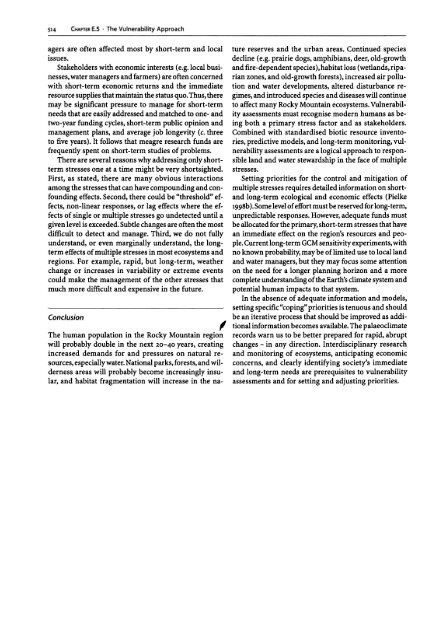How to evaluate vulnerability in changing environmental conditions
How to evaluate vulnerability in changing environmental conditions
How to evaluate vulnerability in changing environmental conditions
Create successful ePaper yourself
Turn your PDF publications into a flip-book with our unique Google optimized e-Paper software.
514<br />
CHAPTER E.5 .The Vulnerability Approach<br />
agers are often affected most by short-term and local<br />
issues.<br />
Stakeholders with economic <strong>in</strong>terests (e.g. local bus<strong>in</strong>esses,<br />
water managers and farmers) are often concerned<br />
with short-term economic returns and the immediate<br />
resource supplies that ma<strong>in</strong>ta<strong>in</strong> the status quo. Thus, there<br />
may be significant pressure <strong>to</strong> manage for short-term<br />
needs that are easily addressed and matched <strong>to</strong> one- and<br />
two-year fund<strong>in</strong>g cycles, short-term public op<strong>in</strong>ion and<br />
management plans, and average job longevity (c. three<br />
<strong>to</strong> five years). It follows that meagre research funds are<br />
frequently spent on short-term studies of problems.<br />
There are several reasons why address<strong>in</strong>g only shortterm<br />
stresses one at a time might be very shortsighted.<br />
First, as stated, there are many obvious <strong>in</strong>teractions<br />
among the stresses that can have compound<strong>in</strong>g and confound<strong>in</strong>g<br />
effects. Second, there could be "threshold" effects,<br />
non-l<strong>in</strong>ear responses, or lag effects where the effects<br />
of s<strong>in</strong>gle or multiple stresses go undetected until a<br />
given level is exceeded. Subtle changes are often the most<br />
difficult <strong>to</strong> detect and manage. Third, we do not fully<br />
understand, or even marg<strong>in</strong>ally understand, the longterm<br />
effects of multiple stresses <strong>in</strong> most ecosystems and<br />
regions. For example, rapid, but long-term, weather<br />
change or <strong>in</strong>creases <strong>in</strong> variability or extreme events<br />
could make the management of the other stresses that<br />
much more difficult and expensive <strong>in</strong> the future.<br />
Conclusion<br />
I<br />
The human population <strong>in</strong> the Rocky Mounta<strong>in</strong> region<br />
will probably double <strong>in</strong> the next 20-40 years, creat<strong>in</strong>g<br />
<strong>in</strong>creased demands for and pressures on natural resources,<br />
especially water. National parks, forests, and wilderness<br />
areas will probably become <strong>in</strong>creas<strong>in</strong>gly <strong>in</strong>sular,<br />
and habitat fragmentation will <strong>in</strong>crease <strong>in</strong> the na-<br />
ture reserves and the urban areas. Cont<strong>in</strong>ued species<br />
decl<strong>in</strong>e (e.g. prairie dogs, amphibians, deer, old-growth<br />
and fire-dependent species), habitat loss (wetlands, riparian<br />
zones, and old-growth forests), <strong>in</strong>creased air pollution<br />
and water developments, altered disturbance regimes,<br />
and <strong>in</strong>troduced species and diseases will cont<strong>in</strong>ue<br />
<strong>to</strong> affect many Rocky Mounta<strong>in</strong> ecosystems. Vulnerability<br />
assessments must recognise modern humans as be<strong>in</strong>g<br />
both a primary stress fac<strong>to</strong>r and as stakeholders.<br />
Comb<strong>in</strong>ed with standardised biotic resource <strong>in</strong>ven<strong>to</strong>ries,<br />
predictive models, and long-term moni<strong>to</strong>r<strong>in</strong>g, <strong>vulnerability</strong><br />
assessments are a logical approach <strong>to</strong> responsible<br />
land and water stewardship <strong>in</strong> the face of multiple<br />
stresses.<br />
Sett<strong>in</strong>g priorities for the control and mitigation of<br />
multiple stresses requires detailed <strong>in</strong>formation on shortand<br />
long-term ecological and economic effects (Pielke<br />
1998b). Some level of effort must be reserved for long-term,<br />
unpredictable responses. <strong>How</strong>ever, adequate funds must<br />
be allocated for the primary, short -term stresses that have<br />
an immediate effect on the region's resources and people.<br />
Current long-term GCM sensitivity experiments, with<br />
no known probability, may be of limited use <strong>to</strong> local land<br />
and water managers, but they may focus some attention<br />
on the need for a longer plann<strong>in</strong>g horizon and a more<br />
complete understand<strong>in</strong>g of the Earth's climate system and<br />
potential human impacts <strong>to</strong> that system.<br />
In the absence of adequate <strong>in</strong>formation and models,<br />
sett<strong>in</strong>g specific "cop<strong>in</strong>g" priorities is tenuous and should<br />
be an iterative process that should be improved as additional<br />
<strong>in</strong>formation becomes available. The palaeoclimate<br />
records warn us <strong>to</strong> be better prepared for rapid, abrupt<br />
changes -<strong>in</strong> any direction. Interdiscipl<strong>in</strong>ary research<br />
and moni<strong>to</strong>r<strong>in</strong>g of ecosystems, anticipat<strong>in</strong>g economic<br />
concerns, and clearly identify<strong>in</strong>g society's immediate<br />
and long-term needs are prerequisites <strong>to</strong> <strong>vulnerability</strong><br />
assessments and for sett<strong>in</strong>g and adjust<strong>in</strong>g priorities.














